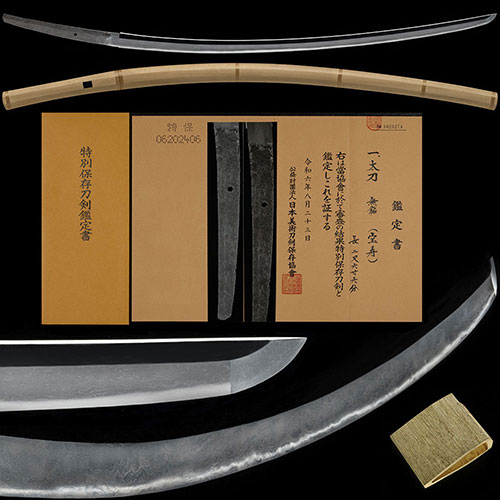
宝寿 太刀Houju Tachi
No.531810宝寿 生ぶ茎太刀 鎌倉時代 身幅3.3cm映り立ち小足葉金筋砂流し頻りに掛る古雅で覇気溢れる傑作 二尺六寸七分Houju Ubu-Nakago Tachi, Kamakura period, Mihaba 3.3cm, Utsuritachi, Small-Ashi and You, Kinsuji and Sunagashi entered frequently, a masterpiece of ancient elegant and full of spirit 80.8cm
商談中Hold
- 極めKiwame
- 宝寿Houju
- 登録証Registration
- 東京都 Tokyo 令和4年10月11日 10/11/4(Reiwa)
- 時代Period
- 鎌倉時代Kamakura period
- 法量Size
-
刃長 80.8cm (二尺六寸七分) 反り 3.0cm
元幅 3.3cm 先幅 2.0cm 元重 0.73cm 鎬厚 0.90cm 先重 0.42cm 鋒長 2.6cm 茎長 25.4cm 重量 950gHachou 80.8cm (二尺六寸七分) Sori 3.0cm
Moto-Haba 3.3cm Saki-Haba 2.0cm Moto-Kasane 0.73cm Shinogi-Thikess 0.90cm Saki-Kasane 0.42cm Kissaki-Chou 2.6cm Nakago-Chou 25.4cm Weight 950g - 国Country
- 平泉Hiraizumi
- 姿Shape
- 鎬造、庵棟、身幅広く、反り深く、腰反り踏ん張り付き、中鋒。Shinogidukuri, Iorimune, Wide Mihaba, Deep Sori, Koshizori-Funbaritsuki, Chu-Kissaki.
- 鍛Kitae
- 板目肌に、流れ肌交じり、地沸微塵につき、地景よく入り、映り立つ。Itamehada, Mixed Nagarehada, Jinie entered fine, Chikei entered frequently, Utsuritatsu.
- 刃文Hamon
- 直刃調に、小互の目・小乱れ交じり、湯走り掛かり、小足・葉頻りに入り、小沸深くつき、金筋砂流し頻りに掛り、匂口明るく冴える。Suguha-style, Small-Gunome, Mixed Small-Midare, Yubashiri-kakari, Small-Ashi and You entered frequently, Small-Nie entered deeply, Kinsuji and Sunagashi entered frequently, Nioikuchi is bright an clear.
- 帽子Boushi
- 直ぐに小丸。Suguni-Komaru
- 茎Nakago
- 生ぶ、先栗尻、鑢目勝手下り、目釘孔一。Ubu, Sakikurijiri, Yasurime-kattesagari, Mekugiana is one(1)
- ハバキHabaki
- 銀無垢。Ginmuku(Solid silver)
- 説明Drscription
- 舞草(もぐさ)鍛冶は、平安中期に陸奥で起こった反乱討伐の前九年の役、五三年の役の後より、寛治元年(1087年)頃から奥州藤原氏の繁栄の元で、平泉で名工を輩出しており、古備前正恒の父も舞草鍛冶であったとという。舞草鍛冶には、在銘作が非常に少なく、在銘作が現存しているのは宝寿のみとなる。宝寿は、舞草鍛冶の代表工で、平安末期に源義経を育てた藤原秀衡の頃から鎌倉時代にかけて平泉で活躍した。この刀は、生ぶ茎の作刀時の姿を留めた希少なもので、80cmを超える長さに、身幅3.3cmあり、反り深く、腰反り・踏ん張り付き、鋒小さくなる時代の上がる豪壮な太刀姿で、宝寿の特色である肌立った地鉄に、小乱れ・小互の目交じり、小足・葉頻りに入り、小沸深くつき、金筋砂流し頻りに掛り、匂口明るく冴える古雅で覇気溢れる傑作である。Mogusa smithing began in the middle of the Heian period, after the 9-year war and the 53-year war to suppress the rebellion that occurred in Mutsu, and from around 1087 under the prosperity of the Oshu Fujiwara clan. , Hiraizumi produced master craftsmen, and it is said that the father of Ko-Bizen Masatsune was also a Mogusa smith. There are very few works with signatures in Mogusa blacksmiths, and Houju is the only one with signatures. Houju is the representative of Mogusa blacksmiths, active in Hiraizumi from the time of Fujiwarano Hidehira, who nurtured Minamoto no Yoshitsune at the end of the Heian period, through the Kamakura period.
This sword is a rare Ubu-Nakago tat retains the original shape of the original Katana, with a length of over 80cm and Mihaba 3.3cm, Deep Sori, Koshizori, Funbaritsuki, The magnificent sword, This sword, with its grand, ancient appearance from the era when Kissaki swords were becoming smaller, The characteristically smooth texture of Houju is Hadatatta Jigane. Small-Midare, Mixed Small-Gunome, There are small-ashy and You entered frequently, Small-Nie entered deeply, Kinsuji and Sunagashi-shikirinikakari, Nioikuchi is bright and clear, It is a masterpiece that is elegant and full of spirit.


